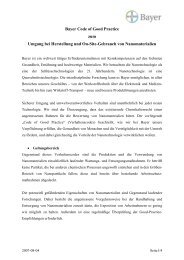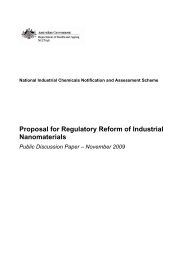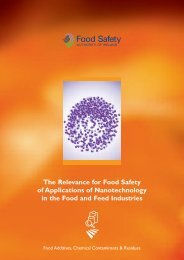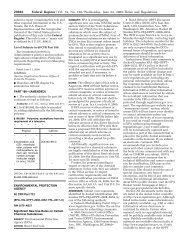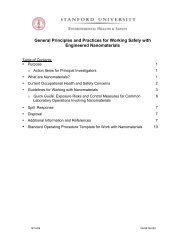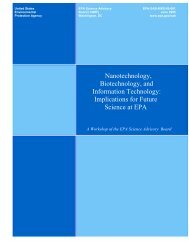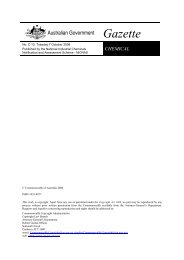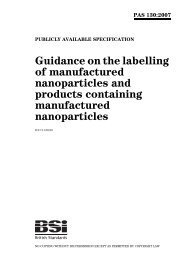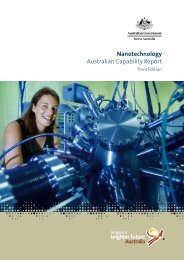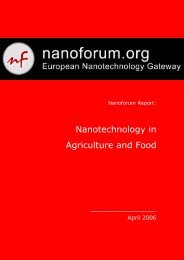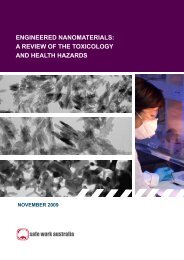L 342/62ENOfficial Journal <strong>of</strong> <strong>the</strong> <strong>European</strong> Union 22.12.<strong>2009</strong>(39) Council Directive 86/609/E<strong>EC</strong> <strong>of</strong> 24 <strong>No</strong>vember 1986 on<strong>the</strong> approximation <strong>of</strong> laws, regulations and administrativeprovisions <strong>of</strong> <strong>the</strong> Member States regarding <strong>the</strong> protection<strong>of</strong> animals used for experimental and o<strong>the</strong>r scientific purposes( 1 ) established common rules for <strong>the</strong> use <strong>of</strong> animalsfor experimental purposes within <strong>the</strong> Community and laiddown <strong>the</strong> conditions under which such experiments mustbe carried out in <strong>the</strong> territory <strong>of</strong> <strong>the</strong> Member States. In particular,Article 7 <strong>of</strong> that Directive requires that animalexperiments be replaced by alternative methods, wheresuch methods exist and are scientifically satisfactory.(40) The safety <strong>of</strong> cosmetic products and <strong>the</strong>ir ingredients maybe ensured through <strong>the</strong> use <strong>of</strong> alternative methods whichare not necessarily applicable to all uses <strong>of</strong> chemical ingredients.Therefore, <strong>the</strong> use <strong>of</strong> such methods by <strong>the</strong> wholecosmetic industry should be promoted and <strong>the</strong>ir adoptionat Community level ensured, where such methods <strong>of</strong>fer anequivalent level <strong>of</strong> protection to consumers.(41) The safety <strong>of</strong> finished cosmetic products can already beensured on <strong>the</strong> basis <strong>of</strong> knowledge <strong>of</strong> <strong>the</strong> safety <strong>of</strong> <strong>the</strong>ingredients that <strong>the</strong>y contain. Provisions prohibiting animaltesting <strong>of</strong> finished cosmetic products should <strong>the</strong>reforebe laid down. The application, in particular by small andmedium-sized enterprises, <strong>of</strong> both test methods and assessmentprocedures for relevant available data, including <strong>the</strong>use <strong>of</strong> read-across and weight-<strong>of</strong>-evidence approaches,which do not involve <strong>the</strong> use <strong>of</strong> animals for assessing <strong>the</strong>safety <strong>of</strong> finished cosmetic products could be facilitated byCommission guidelines.(42) It will gradually become possible to ensure <strong>the</strong> safety <strong>of</strong>ingredients used in cosmetic products by using non-animalalternative methods validated at Community level, orapproved as being scientifically validated, by <strong>the</strong> <strong>European</strong>Centre for <strong>the</strong> Validation <strong>of</strong> Alternative Methods (<strong>EC</strong>VAM)and with due regard to <strong>the</strong> development <strong>of</strong> validationwithin <strong>the</strong> Organisation for Economic Cooperation andDevelopment (O<strong>EC</strong>D). After consulting <strong>the</strong> SCCS asregards <strong>the</strong> applicability <strong>of</strong> <strong>the</strong> validated alternative methodsto <strong>the</strong> field <strong>of</strong> cosmetic products, <strong>the</strong> Commissionshould immediately publish <strong>the</strong> validated or approvedmethods recognised as being applicable to such ingredients.In order to achieve <strong>the</strong> highest possible degree <strong>of</strong> animalprotection, a deadline should be set for <strong>the</strong>introduction <strong>of</strong> a definitive prohibition.(43) The Commission established timetables <strong>of</strong> deadlines upto 11 March <strong>2009</strong> for prohibiting <strong>the</strong> marketing <strong>of</strong> cosmeticproducts, <strong>the</strong> final formulation, ingredients or combinations<strong>of</strong> ingredients which have been tested onanimals, and for prohibiting each test currently carried outusing animals. In view, however, <strong>of</strong> tests concerningrepeated-dose toxicity, reproductive toxicity and toxicokinetics,it is appropriate for <strong>the</strong> final deadline for prohibiting<strong>the</strong> marketing <strong>of</strong> cosmetic products for which those( 1 ) OJ L 358, 18.12.1986, p. 1.tests are used to be 11 March 2013. On <strong>the</strong> basis <strong>of</strong> annualreports, <strong>the</strong> Commission should be authorised to adapt <strong>the</strong>timetables within <strong>the</strong> abovementioned maximum timelimit.(44) Better coordination <strong>of</strong> resources at Community level willcontribute to increasing <strong>the</strong> scientific knowledge indispensablefor <strong>the</strong> development <strong>of</strong> alternative methods. It isessential, for this purpose, that <strong>the</strong> Community continueand increase its efforts and take <strong>the</strong> measures necessary for<strong>the</strong> promotion <strong>of</strong> research and <strong>the</strong> development <strong>of</strong> newnon-animal alternative methods, in particular within itsFramework Programmes for research.(45) The recognition by third countries <strong>of</strong> alternative methodsdeveloped in <strong>the</strong> Community should be encouraged. Inorder to achieve this objective, <strong>the</strong> Commission and <strong>the</strong>Member States should take all appropriate steps to facilitateacceptance <strong>of</strong> such methods by <strong>the</strong> O<strong>EC</strong>D. The Commissionshould also endeavour, within <strong>the</strong> framework <strong>of</strong><strong>European</strong> Community cooperation agreements, to obtainrecognition <strong>of</strong> <strong>the</strong> results <strong>of</strong> safety tests carried out in <strong>the</strong>Community using alternative methods so as to ensure that<strong>the</strong> export <strong>of</strong> cosmetic products for which such methodshave been used is not hindered and to prevent or avoidthird countries requiring <strong>the</strong> repetition <strong>of</strong> such tests usinganimals.(46) Transparency is needed regarding <strong>the</strong> ingredients used incosmetic products. Such transparency should be achievedby indication <strong>of</strong> <strong>the</strong> ingredients used in a cosmetic producton its packaging. Where for practical reasons it isimpossible to indicate <strong>the</strong> ingredients on <strong>the</strong> packaging,such information should be enclosed so that <strong>the</strong> consumerhas access to this information.(47) A glossary <strong>of</strong> common ingredient names should be compiledby <strong>the</strong> Commission to ensure uniform labelling andto facilitate identification <strong>of</strong> cosmetics ingredients. Thisglossary should not be intended to constitute a limitativelist <strong>of</strong> substances used in cosmetic products.(48) In order to inform consumers, cosmetic products shouldbear precise and easily understandable indications concerning<strong>the</strong>ir durability for use. Given that consumersshould be informed <strong>of</strong> <strong>the</strong> date until which <strong>the</strong> cosmeticproduct will continue to fulfil its initial function andremain safe, it is important to know <strong>the</strong> date <strong>of</strong> minimumdurability, i.e. <strong>the</strong> date by which it is best to use <strong>the</strong> product.Where <strong>the</strong> minimum durability is more than 30months, <strong>the</strong> consumer should be informed <strong>of</strong> <strong>the</strong> period <strong>of</strong>time after opening that <strong>the</strong> cosmetic product may be usedwithout any harm to <strong>the</strong> consumer. However, this requirementshould not apply where <strong>the</strong> concept <strong>of</strong> <strong>the</strong> durabilityafter opening is not relevant, that is to say for single-useproducts, products not at risk <strong>of</strong> deterioration or productswhich do not open.
22.12.<strong>2009</strong>ENOfficial Journal <strong>of</strong> <strong>the</strong> <strong>European</strong> Union L 342/63(49) A number <strong>of</strong> substances have been identified by <strong>the</strong> SCCSas likely to cause allergic reactions and it will be necessaryto restrict <strong>the</strong>ir use and/or impose certain conditions concerning<strong>the</strong>m. In order to ensure that consumers areadequately informed, <strong>the</strong> presence <strong>of</strong> <strong>the</strong>se substancesshould be mentioned in <strong>the</strong> list <strong>of</strong> ingredients and consumers’attention should be drawn to <strong>the</strong> presence <strong>of</strong> <strong>the</strong>seingredients. This information should improve <strong>the</strong> diagnosis<strong>of</strong> contact allergies among consumers and shouldenable <strong>the</strong>m to avoid <strong>the</strong> use <strong>of</strong> cosmetic products which<strong>the</strong>y do not tolerate. For substances which are likely tocause allergy to a significant part <strong>of</strong> <strong>the</strong> population, o<strong>the</strong>rrestrictive measures such as a ban or a restriction <strong>of</strong> concentrationshould be considered.containing substances which have raised serious doubts interms <strong>of</strong> safety.(55) This <strong>Regulation</strong> is without prejudice to <strong>the</strong> possibility forMember States to regulate, in compliance with Communitylaw, <strong>the</strong> notification by health pr<strong>of</strong>essionals or consumers<strong>of</strong> serious undesirable effects to <strong>the</strong> competent authorities<strong>of</strong> Member States.(56) This <strong>Regulation</strong> is without prejudice to <strong>the</strong> possibility forMember States to regulate, in compliance with Communitylaw, <strong>the</strong> establishment <strong>of</strong> economic operators in <strong>the</strong> area<strong>of</strong> cosmetic products.(50) In <strong>the</strong> safety assessment <strong>of</strong> a cosmetic product it should bepossible to take into account results <strong>of</strong> risk assessmentsthat have been carried out in o<strong>the</strong>r relevant areas. The use<strong>of</strong> such data should be duly substantiated and justified.(57) In case <strong>of</strong> non-compliance with this <strong>Regulation</strong>, a clear andefficient procedure for <strong>the</strong> withdrawal and recall <strong>of</strong> productsmay be necessary. This procedure should, where possible,build upon existing Community rules for unsafegoods.(51) The consumer should be protected from misleading claimsconcerning efficacy and o<strong>the</strong>r characteristics <strong>of</strong> cosmeticproducts. In particular Directive 2005/29/<strong>EC</strong> <strong>of</strong> <strong>the</strong> <strong>European</strong>Parliament and <strong>of</strong> <strong>the</strong> Council <strong>of</strong> 11 May 2005 concerningunfair business-to-consumer commercial practicesin <strong>the</strong> internal market ( 1 ) is applicable. Fur<strong>the</strong>rmore, <strong>the</strong>Commission, in cooperation with Member States, shoulddefine common criteria in relation to specific claims forcosmetic products.(58) In order to address cosmetic products which, despite complyingwith <strong>the</strong> provisions <strong>of</strong> this <strong>Regulation</strong>, might endangerhuman health, a safeguard procedure should beintroduced.(59) The Commission should provide indications for <strong>the</strong> uniforminterpretation and application <strong>of</strong> <strong>the</strong> concept <strong>of</strong> seriousrisks in order to facilitate <strong>the</strong> consistentimplementation <strong>of</strong> this <strong>Regulation</strong>.(52) It should be possible to claim on a cosmetic product thatno animal testing was carried out in relation to its development.The Commission, in consultation with <strong>the</strong> MemberStates, has developed guidelines to ensure thatcommon criteria are applied in <strong>the</strong> use <strong>of</strong> claims and thatan aligned understanding <strong>of</strong> <strong>the</strong> claims is reached, and inparticular that such claims do not mislead <strong>the</strong> consumer.In developing such guidelines, <strong>the</strong> Commission has alsotaken into account <strong>the</strong> views <strong>of</strong> <strong>the</strong> many small andmedium-sized enterprises which make up <strong>the</strong> majority <strong>of</strong><strong>the</strong> ‘non-animal testing’ producers, relevant nongovernmentalorganisations, and <strong>the</strong> need for consumersto be able to make practical distinctions between productson <strong>the</strong> basis <strong>of</strong> animal testing criteria.(53) In addition to <strong>the</strong> labelled information, consumers shouldbe given <strong>the</strong> possibility to request certain product-relatedinformation from <strong>the</strong> responsible person in order to makeinformed product choices.(54) Effective market surveillance is necessary in order to ensurethat <strong>the</strong> provisions <strong>of</strong> this <strong>Regulation</strong> are respected. To thisend, serious undesirable effects should be notified andcompetent authorities should have a possibility to requestfrom <strong>the</strong> responsible person a list <strong>of</strong> cosmetic products( 1 ) OJ L 149, 11.6.2005, p. 22.(60) In order to comply with principles <strong>of</strong> good administrativepractices, any decision by a competent authority in <strong>the</strong>framework <strong>of</strong> market surveillance should be dulysubstantiated.(61) In order to ensure effective in-market control, a highdegree <strong>of</strong> administrative cooperation amongst <strong>the</strong> competentauthorities is necessary. This concerns in particularmutual assistance in <strong>the</strong> verification <strong>of</strong> product informationfiles located in ano<strong>the</strong>r Member State.(62) The Commission should be assisted by <strong>the</strong> SCCS, an independentrisk assessment body.(63) The measures necessary for <strong>the</strong> implementation <strong>of</strong> this<strong>Regulation</strong> should be adopted in accordance with CouncilDecision 1999/468/<strong>EC</strong> <strong>of</strong> 28 June 1999 laying down <strong>the</strong>procedures for <strong>the</strong> exercise <strong>of</strong> implementing powers conferredon <strong>the</strong> Commission ( 2 ).(64) In particular, power should be conferred on <strong>the</strong> Commissionto adapt <strong>the</strong> Annexes to this <strong>Regulation</strong> to technicalprogress. Since those measures are <strong>of</strong> general scope and aredesigned to amend non-essential elements <strong>of</strong> this <strong>Regulation</strong><strong>the</strong>y must be adopted in accordance with <strong>the</strong> regulatoryprocedure with scrutiny provided for in Article 5a <strong>of</strong>Decision 1999/468/<strong>EC</strong>.( 2 ) OJ L 184, 17.7.1999, p. 23.



